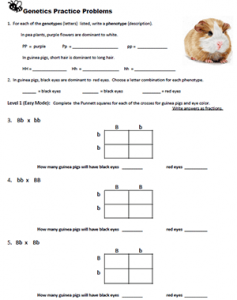
This worksheet was created for an introductory level biology class. Many of these students had not been successful in a regular track class, so I wanted to take a very slow approach to doing genetics. Punnett squares can frustrate many students when they are just learning. This worksheet is designed to move through difficulty levels, so students start with “easy mode.”
Easy mode has the Punnett squares already set up and students just need to fill in the boxes and count how many of each type of guinea pig is expected. Even when I model this procedure, some of my students still have trouble figuring out how to pull letters down and across.
Once students have mastered this skill, they move on to “normal mode” where they must set up the squares themselves.
For many students, this is a challenge, they seem to struggle with where to put each parent. Some students get this right away, which leaves to classroom management issues when you are trying to help students and others are finished, and bored.
Those students are given the “hard mode” page which is on Scottish Fold cats and requires them to figure out genotypes, set up squares, and make predictions about kittens.

Students who are working on the hard mode page are told they will not receive help right away, and that’s the point of hard mode, they need to do it on their own. (This affords me time to work with the students who are struggling with the other pages.)
There are several practice genetics problems in my library, such as Simple Genetics Practice Problems, which you can also assign to those students who are forging ahead. I do not do dihybrid crosses or sex-linked crosses with this class.
Grade Level: 7-12
Time Required: Variable, depending on skill level (10 minutes to 30 minutes)

